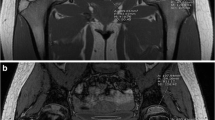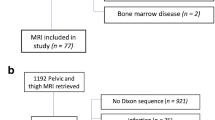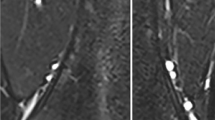Abstract
Background
Pediatric bone marrow assessment by MRI is challenging and primarily experiential and qualitative, with a paucity of clinically useful quantitative imaging techniques.
Objective
MRI fat fraction (MRI-FF) is a technique used to quantify the degree of fat in other organ systems. The purpose of this study was to assess whether MRI-FF accurately measures bone marrow composition.
Materials and methods
This two-part study included a validation phase, followed by an application phase. For the validation phase, the MRI-FF of piglet bones (6 long bones, 8 axial bones) was performed at 1.5 tesla (T) and 3.0 T, and correlated to the histological fat fraction (H-FF). We used Bland–Altman plots to compare MRI-FF at 1.5 tesla T and 3.0 T. For the application phase, five children with malignant marrow disease were recruited along with seven age- and gender-matched control subjects. The MRI-FF in the children was correlated to the H-FF. Boxplots were used to compare the MRI-FF of patients and control subjects.
Results
For the validation animal study, the MRI-FF of piglet bones at both 1.5 T and 3.0 T demonstrated moderate positive correlation to H-FF (r=0.41 and 0.42, respectively). MRI-FF at 1.5 T and 3.0 T were in good agreement, on average 7.7% apart. For the application phase, we included 5 children (4 with leukemia, 1 rhabdomyosarcoma) with median age 7 years, range (3–10 years). All children had MRI-FF and H-FF below 10%. The MRI-FF in patients (3.8±1.2) was significantly lower than that of control subjects (46.1±12.3%) (P<0.01).
Conclusion
MRI-FF is a valid technique to assess bone marrow fat fraction at both 1.5 T and 3.0 T. The MRI-FF in children with malignant marrow processes is significantly lower than in control subjects with normal marrow.








Similar content being viewed by others
References
Chan BY, Gill KG, Rebsamen SL, Nguyen JC (2016) MR imaging of pediatric bone marrow. Radiographics 36:1911–1930
Shiga NT, Del Grande F, Lardo O, Fayad LM (2013) Imaging of primary bone tumors: determination of tumor extent by non-contrast sequences. Pediatr Radiol 43:1017–1023
Bracken J, Nandurkar D, Radhakrishnan K, Ditchfield M (2013) Normal paediatric bone marrow: magnetic resonance imaging appearances from birth to 5 years. J Med Imaging Radiat Oncol 57:283–291
Burdiles A, Babyn PS (2009) Pediatric bone marrow MR imaging. Magn Reson Imaging Clin N Am 17:391–409
Matcuk GR Jr, Siddiqi I, Cen S et al (2016) Bone marrow cellularity MRI calculation and correlation with bone marrow biopsy. Clin Imaging 40:392–397
Karampinos DC, Ruschke S, Dieckmeyer M et al (2018) Quantitative MRI and spectroscopy of bone marrow. J Magn Reson Imaging 47:332–353
Kumar NM, Ahlawat S, Fayad LM (2018) Chemical shift imaging with in-phase and opposed-phase sequences at 3 T: what is the optimal threshold, measurement method, and diagnostic accuracy for characterizing marrow signal abnormalities? Skelet Radiol 47:1661–1671
Deng J, Fishbein MH, Rigsby CK et al (2014) Quantitative MRI for hepatic fat fraction and T2* measurement in pediatric patients with non-alcoholic fatty liver disease. Pediatr Radiol 44:1379–1387
Bydder M, Yokoo T, Hamilton G et al (2008) Relaxation effects in the quantification of fat using gradient echo imaging. Magn Reson Imaging 26:347–359
Yokoo T, Bydder M, Hamilton G et al (2009) Nonalcoholic fatty liver disease: diagnostic and fat-grading accuracy of low-flip-angle multiecho gradient-recalled-echo MR imaging at 1.5 T. Radiology 251:67–76
Friebert SE, Shepardson LB, Shurin SB et al (1998) Pediatric bone marrow cellularity: are we expecting too much? J Pediatr Hematol Oncol 20:439–443
Thiele J, Kvasnicka HM, Facchetti F et al (2005) European consensus on grading bone marrow fibrosis and assessment of cellularity. Haematologica 90:1128–1132
Yoo HJ, Hong SH, Kim DH et al (2017) Measurement of fat content in vertebral marrow using a modified Dixon sequence to differentiate benign from malignant processes. J Magn Reson Imaging 45:1534–1544
Kuhn JP, Hernando D, Meffert PJ et al (2013) Proton-density fat fraction and simultaneous R2* estimation as an MRI tool for assessment of osteoporosis. Eur Radiol 23:3432–3439
Zhang C, Slade JM, Miller F, Modlesky CM (2020) Quantifying bone marrow fat using standard T1-weighted magnetic resonance images in children with typical development and in children with cerebral palsy. Sci Rep 10:1–8
Gee CS, Nguyen JT, Marquez CJ et al (2015) Validation of bone marrow fat quantification in the presence of trabecular bone using MRI. J Magn Reson Imaging 42:539–544
Pichardo JC, Milner RJ, Bolch WE (2011) MRI measurement of bone marrow cellularity for radiation dosimetry. J Nucl Med 52:1482–1489
Percival ME, Lai C, Estey E, Hourigan CS (2017) Bone marrow evaluation for diagnosis and monitoring of acute myeloid leukemia. Blood Rev 31:185–192
Author information
Authors and Affiliations
Corresponding author
Ethics declarations
Conflicts of interest
None
Additional information
Publisher’s note
Springer Nature remains neutral with regard to jurisdictional claims in published maps and institutional affiliations.
Rights and permissions
About this article
Cite this article
Samet, J.D., Deng, J., Schafernak, K. et al. Quantitative magnetic resonance imaging for determining bone marrow fat fraction at 1.5 T and 3.0 T: a technique to noninvasively assess cellularity and potential malignancy of the bone marrow. Pediatr Radiol 51, 94–102 (2021). https://doi.org/10.1007/s00247-020-04809-8
Received:
Revised:
Accepted:
Published:
Issue Date:
DOI: https://doi.org/10.1007/s00247-020-04809-8




